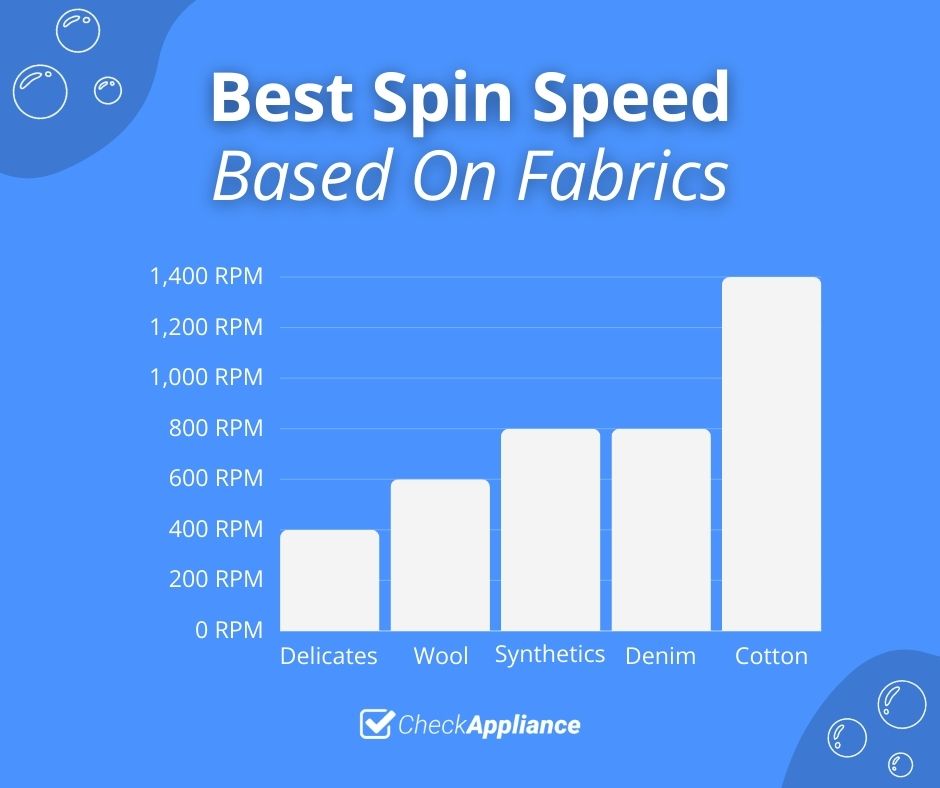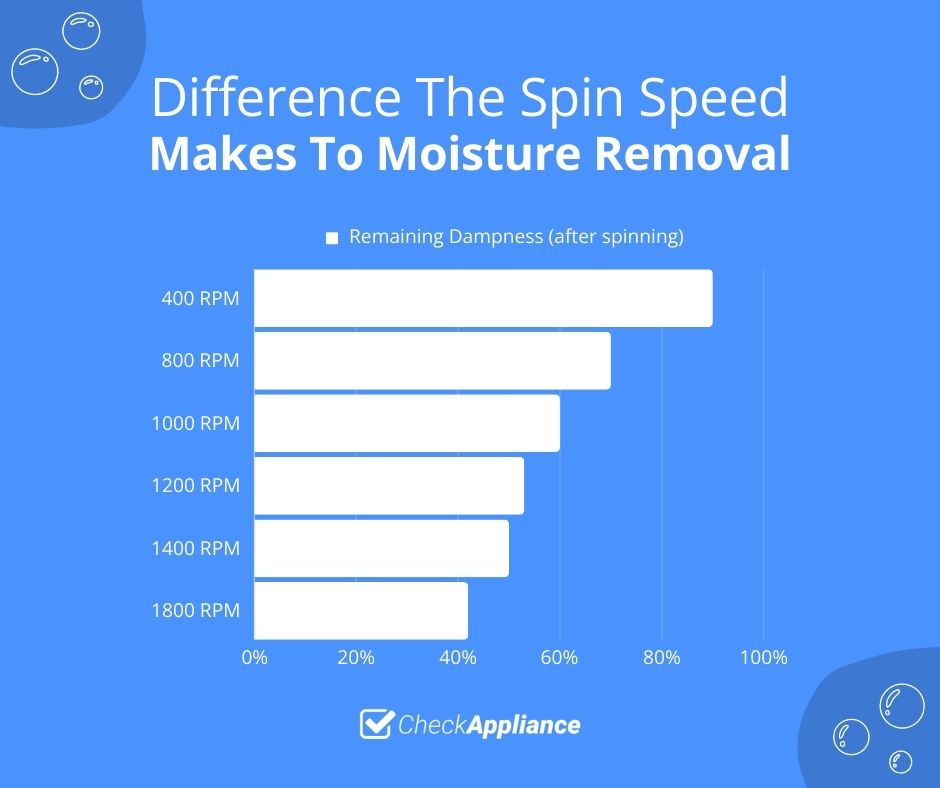
What’s The Lowest Washing Machine Spin Speed?
If you’re thinking of replacing your washing machine, you’ll no doubt be looking at many factors including the spin speeds on new appliances. Pretty much all of the literature concerning washing machines refer to the top spin speed of the appliance.
But what about the lowest spin speed? The lowest spin speed varies depending on the make and model of washer you own. The lowest spin speed is typically 400 RPM although there are some that have 600 RPM as their lowest spin speed.
In this article we look at spin speeds of washing machines concentrating mainly on the lowest spin speed and asking what is it? Is a low spin speed better for laundry? As well as how can the spin speed be adjusted?
What Does The Spin Speed Actually Mean?
The spin speed on a washing machine refers to how many times the drum rotates each minute during the spin cycle and is measured in RPM (revolutions per minute).
For example a spin speed of 1400 RPM indicates that the drum will spin 1,400 times every minute during the spin cycle. The higher the spin speed, the more water that gets extracted from the laundry as it rotates in the drum.
The average top spin speed for washers is around 1400 RPM although there are some models with an 1800 RPM spin speed. At the other end of the scale, the lowest spin speed is typically 400 RPM.
Low spin speeds have their place and can be effective especially with delicate fabrics, but with more robust fabrics a higher spin speed is needed to remove enough water to get the clothes dry in a reasonable time.
What Are The Benefits Of Low Spin Speeds?

The reason for using a high spin speed is to remove as much water from the items of laundry as possible which decreases the amount of time needed to dry those items.
This is because high spin speeds increase the centrifugal force exerted on the garments which forces more water out as the drum spins.
However, there are a few benefits that come with using a low spin speed. Which include;
- Gentler on fabrics
Using lower spin speeds reduces the friction as clothes rub together in the drum as they spin. This is particularly good for delicate fabrics like silk. The lower spin speed also reduces tangling and wear and tear on your clothes. - Clothes last longer
Because the clothes are less likely to become damaged at lower spin speeds, they will last longer and look better for longer. - Reduces creases
Higher spin speeds can cause the garments to become creased and wrinkled. This means that lower spin speeds can mean you don’t need to iron your clothes as much, if at all. - Washing machines last longer
As the drum on the washing machine is spinning slower, it puts less pressure on the drum bearings, the motor and many other components as well. This will increase the longevity of your appliance. - Less noise
As the drum is spinning at a slower rate, there will be less vibration which in turn means less noise. The washer will run quieter at lower spin speeds due to less vibration. - Saves energy
Lower spin speeds consume less energy than higher spin speeds.
Which Spin Speed Is Best To Use Based On fabrics?

On many washing machines, the spin speed is dependent on the programme selected. Many programmes automatically set the spin speed and you don’t need to do anything at all.
However, you can manually alter the spin speed according to the fabrics you intend to wash. In general, the best spin speed for the different types of fabric is listed below. Which are;
| Fabric | Recommended Spin Speed |
|---|---|
| Delicates (silk etc) | 400 RPM |
| Wool | 600 RPM |
| Synthetics | 800 to 1000 RPM |
| Denim | 800 to 1000 RPM |
| Cotton | 1400 RPM |
Delicate Items (silk, lace etc)
Delicate fabrics like silk and lace should only ever be spun at the lowest spin speed available. In most cases this is 400 RPM. If the lowest spin speed on your appliance is higher than 400 RPM, you will probably be better off air drying these delicate items to prevent any damage.
Woollen Items
Woollen items can easily become damaged and are susceptible to shrinking and felting. To prevent this, you should never spin any woollen items any higher than 600 RPM.
Synthetic Items
Synthetic fabrics can withstand slightly higher spin speeds which is why it’s recommended that a spin speed between 800 to 1000 RPM is used when washing garments made from synthetic materials.
Denim Items
Although originally made as workwear, denim isn’t always as robust as you might expect. However, denim can withstand spin speeds of between 800 to 1000 RPM to remove as much moisture as possible.
Cotton Items
Cotton is far more robust and can withstand higher spin speeds. In fact, to remove as much moisture as possible you will need to spin cotton fabrics at spin speeds of 1400 RPM or higher.
How Much Difference Does The Spin Speed Make To Moisture Removal?

There is a correlation between the spin speed used and the amount of moisture removed from the laundry. Which has a knock on effect on the energy needed to tumble dry your clothes.
Here are the rough figures:
| Spin Speed | Remaining Dampness (After Spinning) |
|---|---|
| 400 RPM | 90% |
| 800 RPM | 70% |
| 1000 RPM | 60% |
| 1200 RPM | 53% |
| 1400 RPM | 50% |
| 1800 RPM | 42% |
As you can see, although there’s a significant difference between a 400 RPM spin speed compared to a 1800 RPM spin (over 50%), the difference between the 1200 RPM and 1400 RPM spin speeds isn’t that big.
Whether you need to dry your laundry as much as 42% residual dampness (1800 RPM) compared to 50% (1200 RPM) is a matter only you can decide. But the cost price of a washer with an 1800 RPM spin speed is considerably more than the price of a washer with a top spin speed of 1200 RPM.
What About Performance?

Although the overall care of the fabrics being washed is vitally important when it comes to spin speed, there are other factors to consider. These include;
Efficiency
Higher spin speeds can improve the overall efficiency of your washing machine. The higher the spin speed, the more water that gets removed which reduces dryer times. This can save money and energy overall.
Cleaning
Higher spin speeds result in cleaner clothes. This is because the centrifugal force created as the drum spins faster, helps dislodge dirt, stains as well as detergent residue from your laundry.
Noise Levels
Higher spin speeds will cause the machine to create more noise. This is partly due to vibration and partly due to the sound of the motor and the drum spinning as well.
Fabric Requirements
Whilst high spin speeds can be beneficial in getting certain fabrics clean and dry, delicate fabrics benefit from lower spin speeds. This helps prevent damage, wear and tear and wrinkling in delicate fabrics.
SEE ALSO: How To Stop Clothes Wrinkling In The Washing Machine (best tips)
Frequently Asked Questions
The lowest spin speed on a washing machine can vary depending on the make and model. But most have a minimum spin speed of 400 RPM (revolutions per minute).
The wash cycle with the lowest spin speed is the delicate cycle which typically has a spin speed of 400 RPM.
The best spin speed on a washing machine depends on how dry you want your laundry and the fabrics you are washing. In all honesty the difference between 1400 RPM and 1600 RPM spin speeds in terms of dryness are minimal. However, the purchase price of the appliance can be significantly higher as the maximum spin speed increases. Some fabrics cannot withstand high spin speeds and this needs to be taken into account as well.




